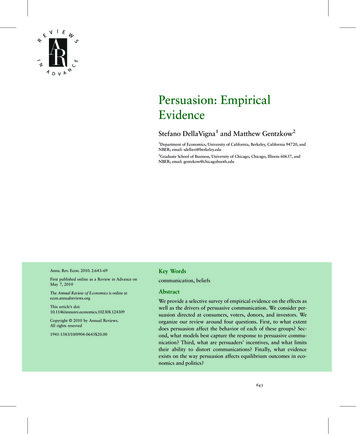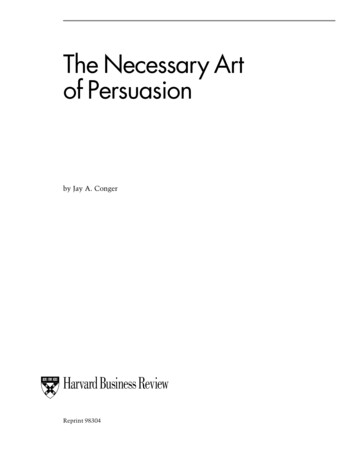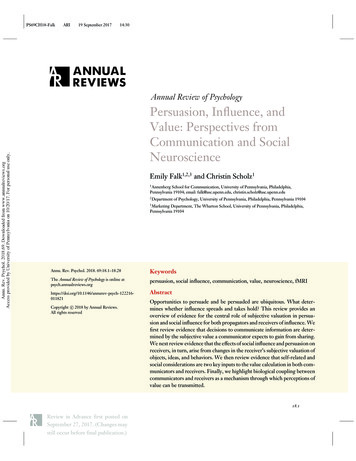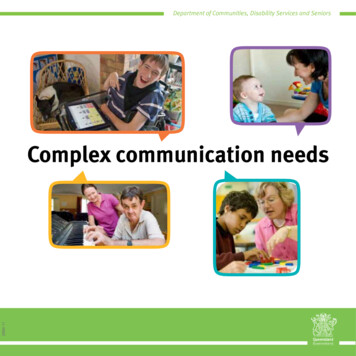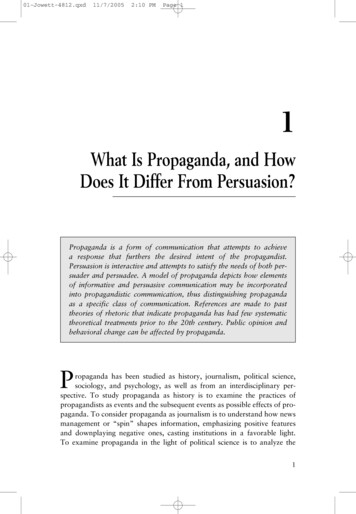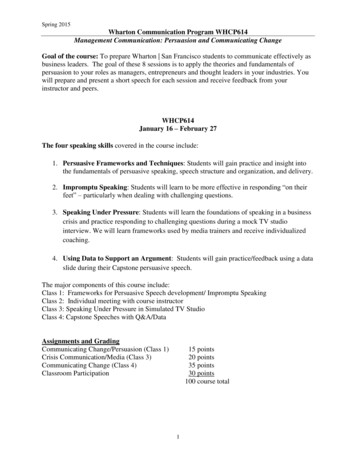
Transcription
Spring 2015Wharton Communication Program WHCP614Management Communication: Persuasion and Communicating ChangeGoal of the course: To prepare Wharton San Francisco students to communicate effectively asbusiness leaders. The goal of these 8 sessions is to apply the theories and fundamentals ofpersuasion to your roles as managers, entrepreneurs and thought leaders in your industries. Youwill prepare and present a short speech for each session and receive feedback from yourinstructor and peers.WHCP614January 16 – February 27The four speaking skills covered in the course include:1. Persuasive Frameworks and Techniques: Students will gain practice and insight intothe fundamentals of persuasive speaking, speech structure and organization, and delivery.2. Impromptu Speaking: Students will learn to be more effective in responding “on theirfeet” – particularly when dealing with challenging questions.3. Speaking Under Pressure: Students will learn the foundations of speaking in a businesscrisis and practice responding to challenging questions during a mock TV studiointerview. We will learn frameworks used by media trainers and receive individualizedcoaching.4. Using Data to Support an Argument: Students will gain practice/feedback using a dataslide during their Capstone persuasive speech.The major components of this course include:Class 1: Frameworks for Persuasive Speech development/ Impromptu SpeakingClass 2: Individual meeting with course instructorClass 3: Speaking Under Pressure in Simulated TV StudioClass 4: Capstone Speeches with Q&A/DataAssignments and GradingCommunicating Change/Persuasion (Class 1)Crisis Communication/Media (Class 3)Communicating Change (Class 4)Classroom Participation15 points20 points35 points30 points100 course total1
Spring 2015Class 1: Communicating Change/Persuasion January 16th (Section 1 meets 9:30 AM,Section 2 meets 2:00 PM) Lecture/Discussion – theories of persuasion, structure and organization of a persuasivespeech, “roadmaps,” governing message and problem definition.Student speeches, playback, feedback and critiqueTo prepare for Class 1- Read assigned course pack readings for Class 1 from study.net- View “The Persuaders” on Canvas- Come prepared to deliver 2-3 minute speech on a self-selected topic of change ------------------AssignmentCommunicating Change/PersuasionThink about a major opportunity or issue your company or industry faces and persuade us (anaudience of decision-makers you identify) to adopt a specific change. If you would like to choosea previous company or a company other than your own, feel free to do so. You will not be ableto use slides or visuals for this presentation (data slide can be used in Class 4).Please keep in mind that any presentation or short talk needs to be organized and interestingand should therefore have a beginning, a middle, and an end. Aim for one overarching(governing) idea with some supporting points. Also, think about using vivid images to makeyour point, whether through the use of examples, analogies, stories, comparison and contrast,etc. The length should be 2-3 minutes.Takeaways- Identification of strengths and areas for development- Techniques for dynamic delivery- Techniques for logical organization of ideasClass 2: Personal Communication Plan/Individual meetings with Instructor and CrisisCommunication guest lectureIndividual Instructor meetings held January 29th for Section 1 and January 30th forSection 2. Sign up through Canvas link. Class 2 will also include a session with guest speakerHelio Fred Garcia, founder and executive director of the Logos Institute for Crisis Managementand Executive Leadership held on the evening opposite your individual meeting with yourinstructor. While Section 1 meets individually with the course instructor in 30 minute intervalson 1/29, Section 2 will hear Fred Garcia’s lecture on speaking under pressure/crisis2
Spring 2015communication. The next evening, 1/30, we will reverse this order with Section 2 attendingindividual meetings with the instructor. The Fred’s presentation will help you prepare for yourcrisis speech scheduled for Class 3 on Saturday Feb 13th.Individual meetings with your instructor are intended to be value-added for the students, and willinclude:1) Review of Class 1 speech to receive individualized feedback.2) Review the individual goals and opportunities worksheetThis meeting is the student's time to get individual feedback and guidance, so please come to thesession with questions and any personal objectives you have for your development.Class 3: Crisis Speech, Data Presentations (guest speaker) February 13th (Section 1 heldfrom 6:20-7:20 PM; Section 2 held from 5:15-6:15 PM. Then sections 1 and 2 will meet togetherfrom 7:30-8:45 PM to hear guest speaker Gene Zelazny from McKinsey & Co discuss datapresentation in preparation for your Class 4 speech ) Lecture/discussion: frameworks and best practices for when speaking when anorganization is in crisis; handling difficult questions Simulated media interview on assigned crisis case Lecture: Say it With Slides – Gene ZelaznyTo Prepare for Class 3- Read selections for class 3 in course pack- Read and prepare a crisis response based on your assigned case- Review crisis video response examples on -------AssignmentBusiness Crisis – Speaking Credibly and PersuasivelyPart of leadership requires that you be able to speak confidently and articulately during a crisis.Decide what your key message is. Prepare and deliver a 30-60 second opening statement andthen take questions from the media. Case materials are found in Canvas. The context andobjectives for your talk are as follows:As a business leader, it’s important to communicate your ideas succinctly and convincingly. Inyour speech we’d like you to:1. Briefly describe the situation your organization is facing2. Briefly explain your position regarding the crisis issue, and any changes yourecommend to address these problems.3. Respond competently to media questions.Since most of your classmates won’t have read your case, your briefing will provide them withthe article basics. Our purpose isn’t to test your expertise. We want to give you practicestructuring and delivering a speech and answering tough questions– especially one in which youneed to choose the information that supports your objectives.3
Spring 2015In evaluating your speech, we’ll focus on the following questions:Was the speech's objective clear and reasonable?Were key points well selected for the listeners?Were arguments well supported?Was delivery style and Q&A response effective?Takeaways-Structuring a message-Using concise and clear statements-Staying on message and answering questionsClass 4: Strategy and Structure for Strong Persuasive Messages February 27th (Section 1February 27th 5:15-7:15 PM; Section 2 7:30 -9:30 PM) Speech on “Communicating Change” with optional data slide to support your position Feedback and critique Course summary and preparation for WHCP619 assignmentsTo prepare for Class 4- Please read assigned course pack readings- Review video examples on -------Assignment:Communicating ChangeWhether a division head or CEO, you play a critical role in responding to change in thecompetitive environment. Think about a major opportunity or issue your company faces andsuggest a specific change. If you would like to choose a previous company or a company otherthan your own, feel free to do so. You will speak for 5 minutes and will be asked questions, sobe prepared to defend your position.Some things to consider:Your ability to explain the complexities of the change or issue is crucial, especially if it isvery technical. You will need to determine the following: Who is your audience? What dothey already know? What do they need to know? What do they want to know? Forexample, if you are an engineer addressing other engineers, for the sake of your audience,you will need to tell us some facts that will help us give you feedback.Be sure to tell your audience your purpose (governing message). This doesn’t have to be inthe first sentence, but you need to be clear – early on – where you’re going with your talk sothat we know your expectations. Also, to help maintain the audience’s attention throughout,emphasize the few key elements you want us to learn from your talk. Since this talk ispersuasive, be clear of what you’re persuading us. Since you can assume we’re asophisticated audience, you will want to address arguments counter to your claim.You will also want to consider both your strategy and structure of this presentation. Strategyrefers to how you will appeal to your audience (ethos – credibility; logos – logical structure;pathos – emotional appeals) and what you want the audience to think, feel and do as a result4
Spring 2015of your talk. Structure refers to how you set up your argument by using organization andvarious persuasive structures that you will find outlined in your course pack.Takeaways-Creating a message specific to a particular audience-Organizing a persuasive argument following a particular structural pattern-Considering Aristotle’s 3 elements of persuasion (ethos/logos/pathos) as a strategy5
Wharton Communication Program WHCP614 Management Communication: Persuasion and Communicating Change Goal of the course: To prepare Wharton San Francisco students to communi
